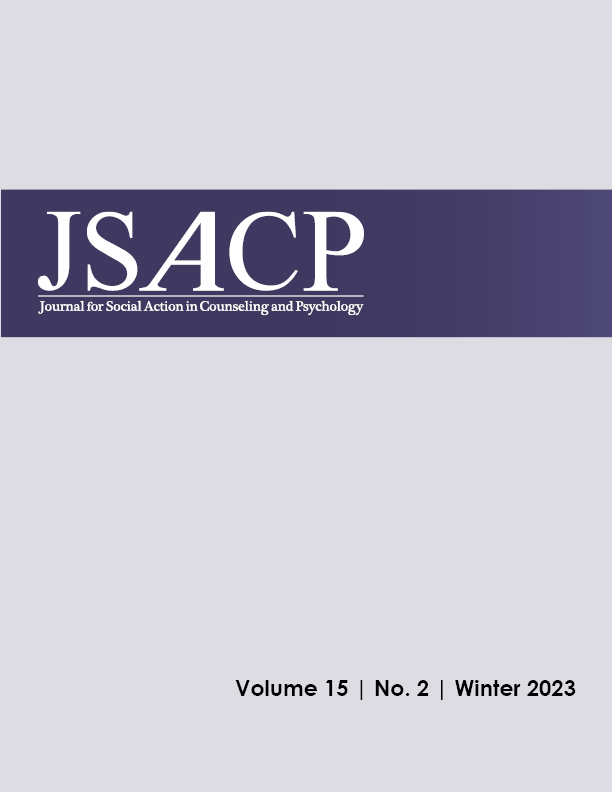We Are Humans Too
Secondary Traumatic Stress Among Novice Victim Advocates
DOI:
https://doi.org/10.33043/JSACP.15.2.2-16Keywords:
secondary traumatic stress, victim advocate, vicarious trauma, secondary trauma, criminal justice, Survivor advocateAbstract
The current manuscript focuses on the experiences of Secondary Traumatic Stress (STS) among novice victim advocates. Victim advocates work with survivors of violent crimes and provide emotional and logistical support to their clients, helping clients navigate the criminal justice system. Through individual interviews, the current study explored how advocates managed their exposure to traumatic events and how they believed it impacted them professionally and personally. Nine victim advocates were interviewed, and principles of thematic analysis were used to code the interviews and analyze the data. From the interviews three major themes emerged related to STS: worldview shifts, secondary traumatic stress symptoms, and burnout. Two major themes emerged related to prevention: colleague support and recognizing successes. Conclusions: Advocates are a particularly vulnerable population of helping professions that are at risk for STS. Increased awareness and acknowledgement of their work will be an important component of intervention efforts. Supporting the needs of novice advocates will be necessary to allow people to sustain in their career, and to be better positioned to support survivors of violent crimes.
Downloads
References
American Psychiatric Association. (2013). Diagnostic and statistical manual of mental disorders (5th ed.). American Psychiatric Pub Inc.
Auerbach, C., & Silverstein, L. (2003). Qualitative data: An introduction to coding and analysis. New York, NY: New York University Press.
Benuto, L. T., Yang, Y., Ahrendt, A., & Cummings, C. (2018). The Secondary Traumatic Stress Scale: Confirmatory factor analyses with a national sample of victim advocates. Journal of Interpersonal Violence, 36(5-6), 1–20, https://doi.org/10.1177/0886260518759657
Benuto, L. T., Newlands, R., Ruork, A., Hooft, S., & Ahrendt, A. (2018). Secondary traumatic stress among victim advocates: prevalence and correlates. Journal of Evidence-Informed Social Work, 15(5), 494-509, https://doi.org/10.1080/23761407.2018.1474825
Bercier, M. L., & Maynard, B. R. (2015). Interventions for secondary traumatic stress with mental health workers: A systematic review. Research on Social Work Practice, 25(1), 81-89, https://doi.org/10.1177/1049731513517142
Bonach, K., & Heckert, A. (2012). Predictors of Secondary Traumatic Stress among Children’s Advocacy Center Forensic Interviewers. Journal of Child Sexual Abuse, 21, 295–314, https://doi.org/ 10.1080/10538712.2012.647263
Braun, V., & Clarke, V. (2021). To saturate or not to saturate? Questioning data saturation as a useful concept for thematic analysis and sample-size rationales. Qualitative research in sport, exercise and health, 13(2), 201-216. https://doi.org/ 10.1080/2159676X.2019.1704846
Bride, B. E., Robinson, M. M., Yegidis, B., & Figley, C. R. (2004). Development and validation of the secondary traumatic stress scale. Research on Social Work Practice, 14(1), 27-35, https://doi.org/10.1177/1049731503254106
Cieslak, R., Shoji, K., Douglas, A., Melville, E., Luszczynska, A., & Benight, C. C. (2014). A meta-analysis of the relationship between job burnout and secondary traumatic stress among workers with indirect exposure to trauma. Psychological Services, 11, 75–86, https://doi.org/10.1037/a0033798
Creswell, J. W. (2007). Qualitative inquiry and research design: Choosing among five traditions (2nd ed.). Thousand Oaks, CA: Sage.
Dedoose. (n.d.). User guide. https://www.dedoose.com/userguide
De La Rue, L., Ortega, L., & Castro-Rodriguez, G. (2023). System-Based Victim Advocates Identify Resources and Barriers to Supporting Crime Victims. International Review of Victimology, 29(1): 16–26, https://doi.org/10.1177/02697580221088340
Elwood, L. S., Mott, J., Lohr, J. M., & Galovski, T. E. (2011). Secondary trauma symptoms in clinicians: A critical review of the construct, specificity, and implications for trauma focused treatment. Clinical Psychology Review, 31, 25–36, https://doi.org/10.1016/j.cpr.2010.09.004
Figley, C. R. (1995). Compassion fatigue: Toward a new understanding of the costs of caring. In B. H. Stamm (Ed.), Secondary traumatic stress: Self-care issues for clinicians, researchers, and educators (pp. 3-28). Baltimore, MD, U.S.: The Sidran Press
Globokar, J., & Erez, E. (2019). Conscience and convenience: American victim work in organizational context. International Review of Victimology, 25(3), 341–357, https://doi.org/10.1177/0269758018805553
Globokar, J. L., Erez, E., & Gregory, C. R. (2016). Beyond advocacy: Mappin the contours of victim work. Journal of Interpersonal Violence, 34(6) 1-26, https://doi.org/10.1177/0886260516650969
Hensel, J. M., Ruiz, C., Finney, C., & Dewa, C. S. (2015). Meta‐analysis of risk factors for secondary traumatic stress in therapeutic work with trauma victims. Journal of Traumatic Stress, 28(2), 83-91, https://doi.org/10.1002/jts.21998
Kolb, K. H. (2011). Sympathy work: Identity and emotion management among victim-advocates and counselors. Qualitative Sociology, 34(1), 101-119, https://doi.org/10.1007/s11133-010-9177-6
Maier, S. L. (2023). Keepers of Trauma: Rape Victim Advocates’ Secondary Traumatic Stress, Burnout, and Coping Techniques. Violence against women, 0(0), https://doi.org/10.1177/10778012231182414
McCann, I. L., & Pearlman, L. A. (1990). Vicarious traumatization: A framework for understanding the psychological effects of working with victims. Journal of Traumatic Stress, 3(1), 131-149.
Powell-Williams, M., White, S. D., & Powell-Williams, T. (2013). “I help the ones that want help”: Emotion work and the victim advocate role. Sociological Spectrum, 33(3), 258-275, https://doi.org/10.1080/02732173.2013.732904
Regehr, C., Hemsworth, D., Leslie, B., Howe, P., & Chau, S. (2004). Predictors of post-traumatic distress in child welfare workers: A linear structural equation model. Children and Youth Services Review, 26(4), 331-346, https://doi.org/10.1016/j.childyouth.2004.02.003
Sered, D. (2019). Until We Reckon. The New York Press.
Strauss, A., & Corbin, J. M. (1990). Basics of qualitative research: Grounded theory procedures and techniques. Sage.
Strauss, A., & Corbin, J. M. (1998). Basics of qualitative research: Grounded theory procedures and techniques (2nd ed.). Sage.
Stewart, M., & Hodgkinson, P. (1994). Post-traumatic stress reactions in the professional. In R. Watts & D.J. de L Horne (Eds.), Coping with trauma: The Victim and the Helper (pp. 53-72). Australian Academic Press.
Szoke, D., Lancaster, C., & Hazlett-Stevens, H. (2023). Relationships between burnout, secondary traumatic stress, mindfulness, and self-compassion in victim advocates. Violence against women, 1-18, https://doi.org/10.1177/10778012231185535
Downloads
Published
How to Cite
Issue
Section
License
Copyright (c) 2024 Lisa De La Rue, Lilyana Ortega, Gena Castro Rodriguez

This work is licensed under a Creative Commons Attribution-NonCommercial-NoDerivatives 4.0 International License.
By submitting to JSACP, the author(s) agree to the terms of the Author Agreement. Beginning in 2018, all authors retain copyrights associated with their article contributions and agree to make such contributions available under a Creative Commons Attribution-NonCommercial-NoDerivatives 4.0 International license upon publication in JSACP. Copyrights to articles published prior to 2018 have been transferred from the authors to JSACP.









